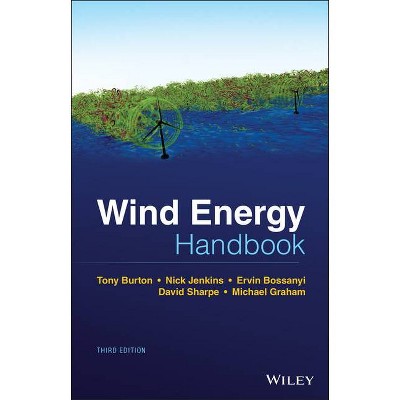Wind Energy 3e C - 3rd Edition by Nick Jenkins & Tony L Burton & Ervin Bossanyi & David Sharpe & Michael Graham (Hardcover)

Similar Products
Products of same category from the store
AllProduct info
<p/><br></br><p><b> About the Book </b></p></br></br>"Fully revised and updated, this third edition addresses key developments in the wind technology since the second edition was published in 2011. Completely new sections on model predictive control; use of estimators for fault detection and fatigue monitoring; active power control; and wind farm control. After a brief introduction, the authors discuss the wind resource. Particular reference is made to wind turbulence due to its importance in wind turbine design. A discussion on the basis of the aerodynamics of horizontal axis wind turbines follows, incorporating general momentum theory and dynamic stall, and an analysis of their performance. The book goes on to assess the requirements for establishing design loads. Burton et al. also set out the various design options for horizontal axis wind turbines, discussing variable speed operation and reviewing alternative blade materials and their properties. They explain the functions of the wind turbine controller and describe some of the possible analysis techniques. The text also reviews the development of wind energy projects with particular emphasis on environmental impact, and considers how wind turbines interact with the electrical power system."--<p/><br></br><p><b> Book Synopsis </b></p></br></br><b><br /></b> <p><b>Fully updated and authoritative reference to wind energy technology written by leading academic and industry professionals</b></p> <p>The newly revised Third Edition of the <i>Wind Energy Handbook</i> delivers a fully updated treatment of key developments in wind technology since the publication of the book's Second Edition in 2011. The criticality of wakes within wind farms is addressed by the addition of an entirely new chapter on wake effects, including 'engineering' wake models and wake control. Offshore, attention is focused for the first time on the design of floating support structures, and the new 'PISA' method for monopile geotechnical design is introduced.</p> <p>The coverage of blade design has been completely rewritten, with an expanded description of laminate fatigue properties and new sections on manufacturing methods, blade testing, leading-edge erosion and bend-twist coupling. These are complemented by new sections on blade add-ons and noise in the aerodynamics chapters, which now also include a description of the Leishman-Beddoes dynamic stall model and an extended introduction to Computational Fluid Dynamics analysis.</p> <p>The importance of the environmental impact of wind farms both on- and offshore is recognized by expanded coverage, and the requirements of the Grid Codes to ensure wind energy plays its full role in the power system are described. The conceptual design chapter has been extended to include a number of novel concepts, including low induction rotors, multiple rotor structures, superconducting generators and magnetic gearboxes.</p> <p>References and further reading resources are included throughout the book and have been updated to cover the latest literature. As in previous editions, the core subjects constituting the essential background to wind turbine and wind farm design are covered. These include: </p> <ul> <li>The nature of the wind resource, including geographical variation, synoptic and diurnal variations, and turbulence characteristics</li> <li>The aerodynamics of horizontal axis wind turbines, including the actuator disc concept, rotor disc theory, the vortex cylinder model of the actuator disc and the Blade-Element/Momentum theory</li> <li>Design loads for horizontal axis wind turbines, including the prescriptions of international standards</li> <li>Alternative machine architectures</li> <li>The design of key components</li> <li>Wind turbine controller design for fixed and variable speed machines</li> <li>The integration of wind farms into the electrical power system</li> <li>Wind farm design, siting constraints, and the assessment of environmental impact</li> </ul> <p>Perfect for engineers and scientists learning about wind turbine technology, the <i>Wind Energy Handbook</i> will also earn a place in the libraries of graduate students taking courses on wind turbines and wind energy, as well as industry professionals whose work requires a deep understanding of wind energy technology.</p><p/><br></br><p><b> About the Author </b></p></br></br><p><b>Tony Burton</b> is a Civil Engineer recently retired from a post in offshore wind turbine support structure design with DNV GL in London, UK. He has worked for a major UK wind turbine manufacturer on the design, construction, commissioning, and operation of both medium and large-scale wind turbines. </p> <p><b>Nick Jenkins</b> is Professor of Renewable Energy at Cardiff University. He has over 14 years of industrial experience and is a Fellow of the IET, IEEE, and Royal Academy of Engineering. </p> <p><b>Ervin Bossanyi</b><b> </b>is Senior Principal Researcher in renewables at DNV GL in Bristol, United Kingdom. He is also Visiting Professor at the University of Bristol. He received the Scientific Award of the European Academy of Wind Energy for outstanding contributions to the development of wind energy. </p> <p><b>David Sharpe </b>is a Researcher in wind turbine aerodynamics, having previously been Senior Lecturer in aeronautical engineering at Queen Mary College and then Senior Research Fellow at the Centre for Renewable Energy Systems Technology at Loughborough University. He is currently a visiting Professor at Strathclyde University. </p> <p><b>Mi</b><b>chael Graham</b> is Professor in the Faculty of Engineering, Department of Aeronautics at Imperial College in London, UK. His research foci are on environmental flows, computational fluid dynamics, and marine technology. </p>
Price History
Price Archive shows prices from various stores, lets you see history and find the cheapest. There is no actual sale on the website. For all support, inquiry and suggestion messagescommunication@pricearchive.us




















